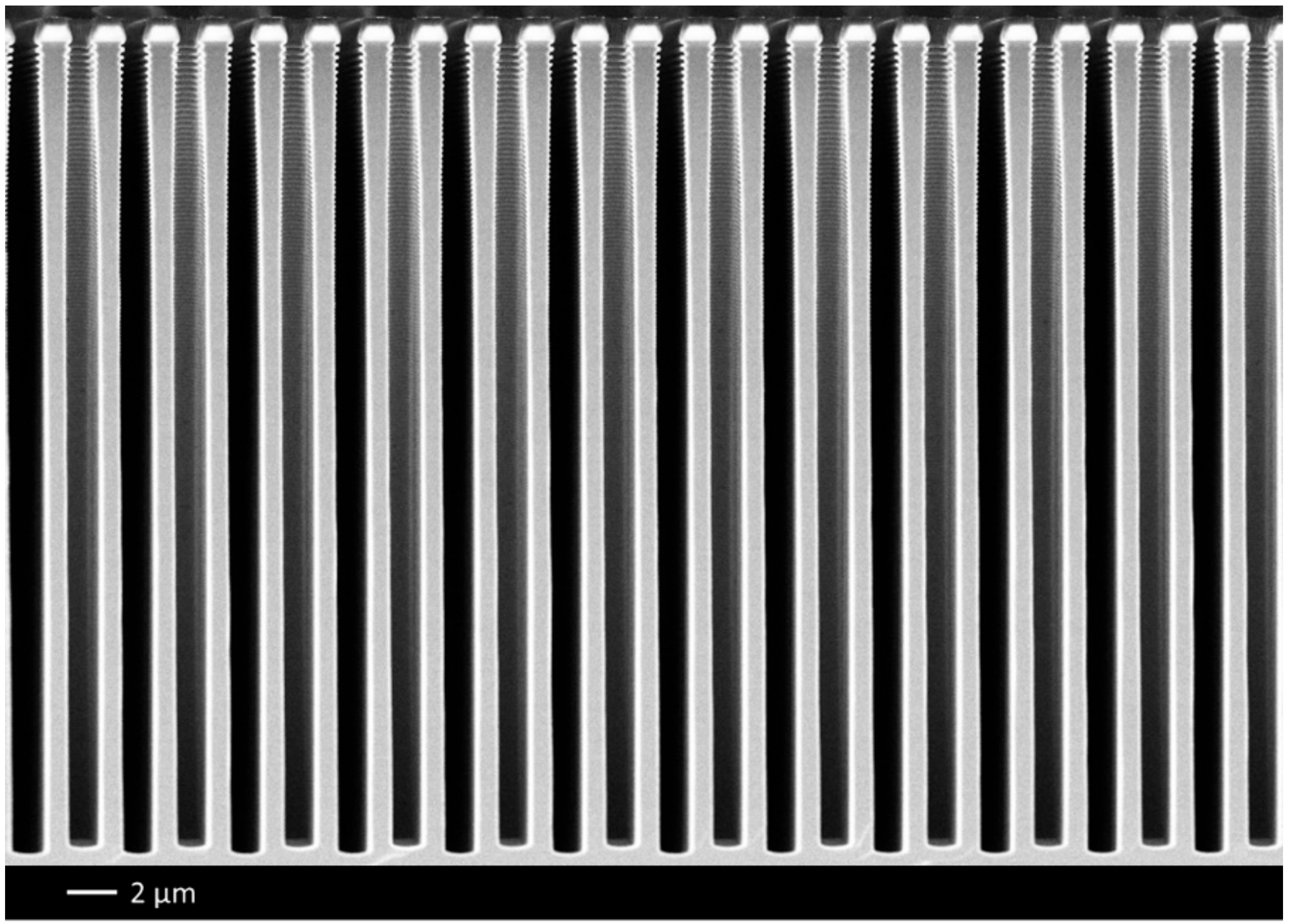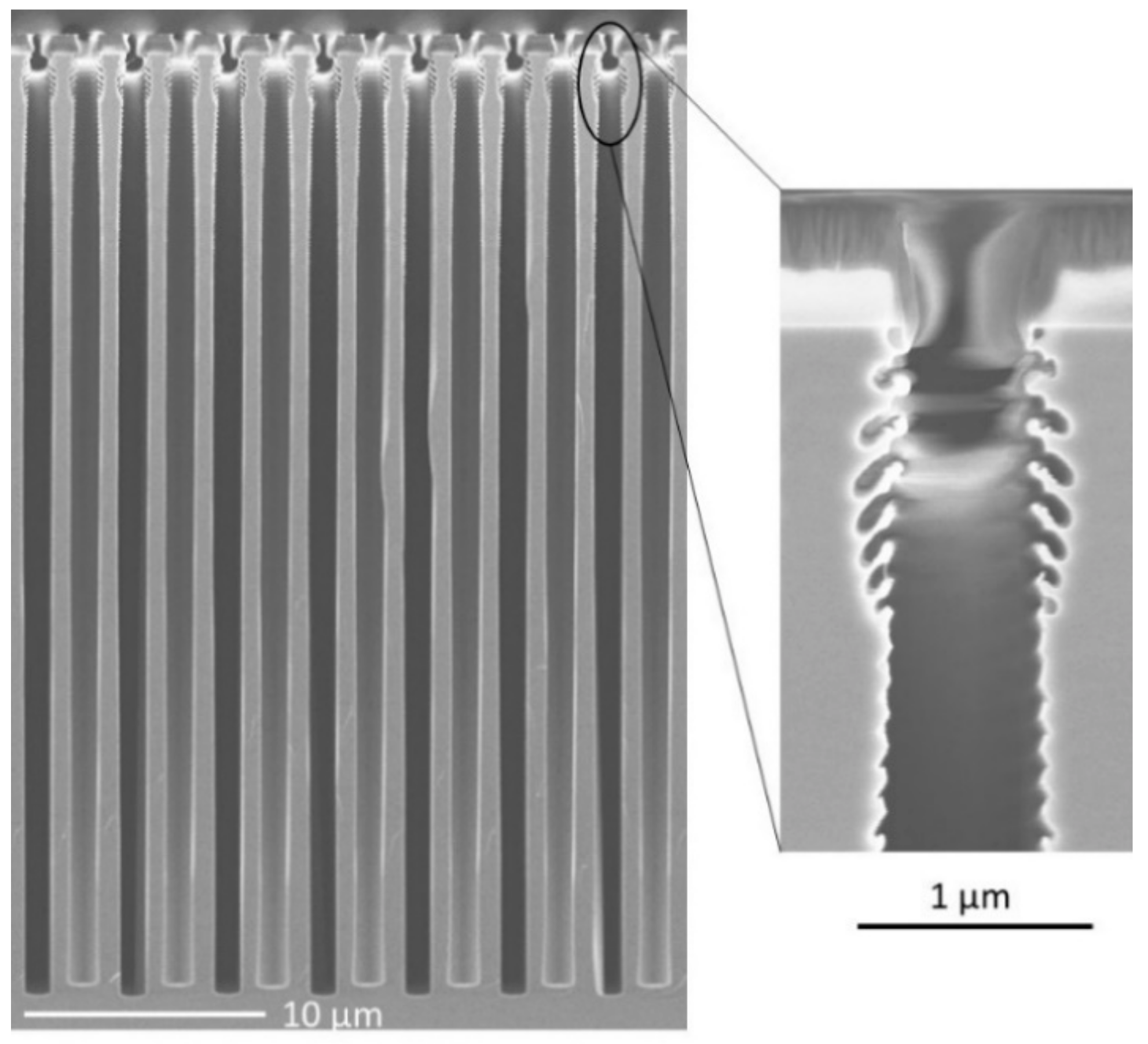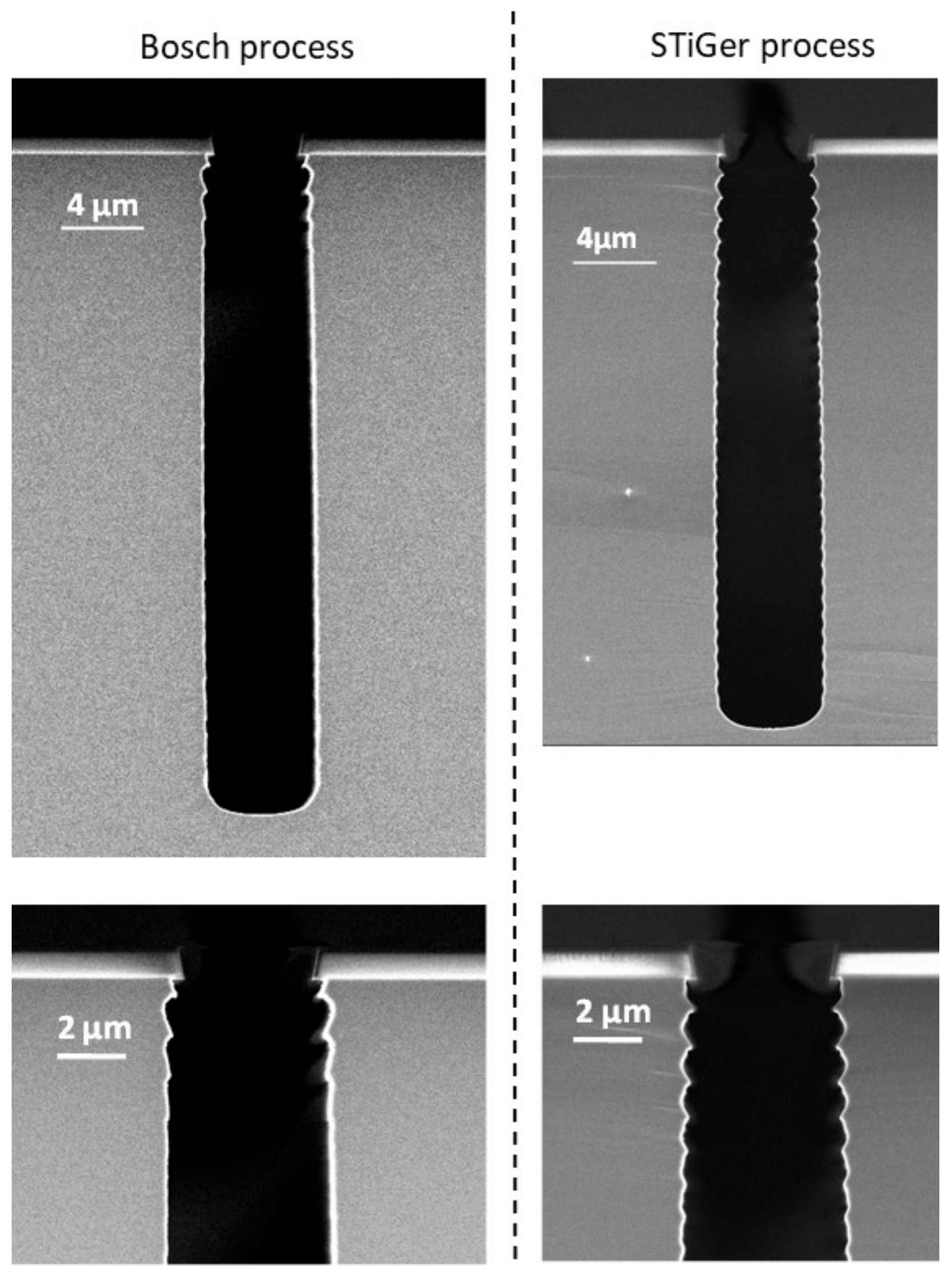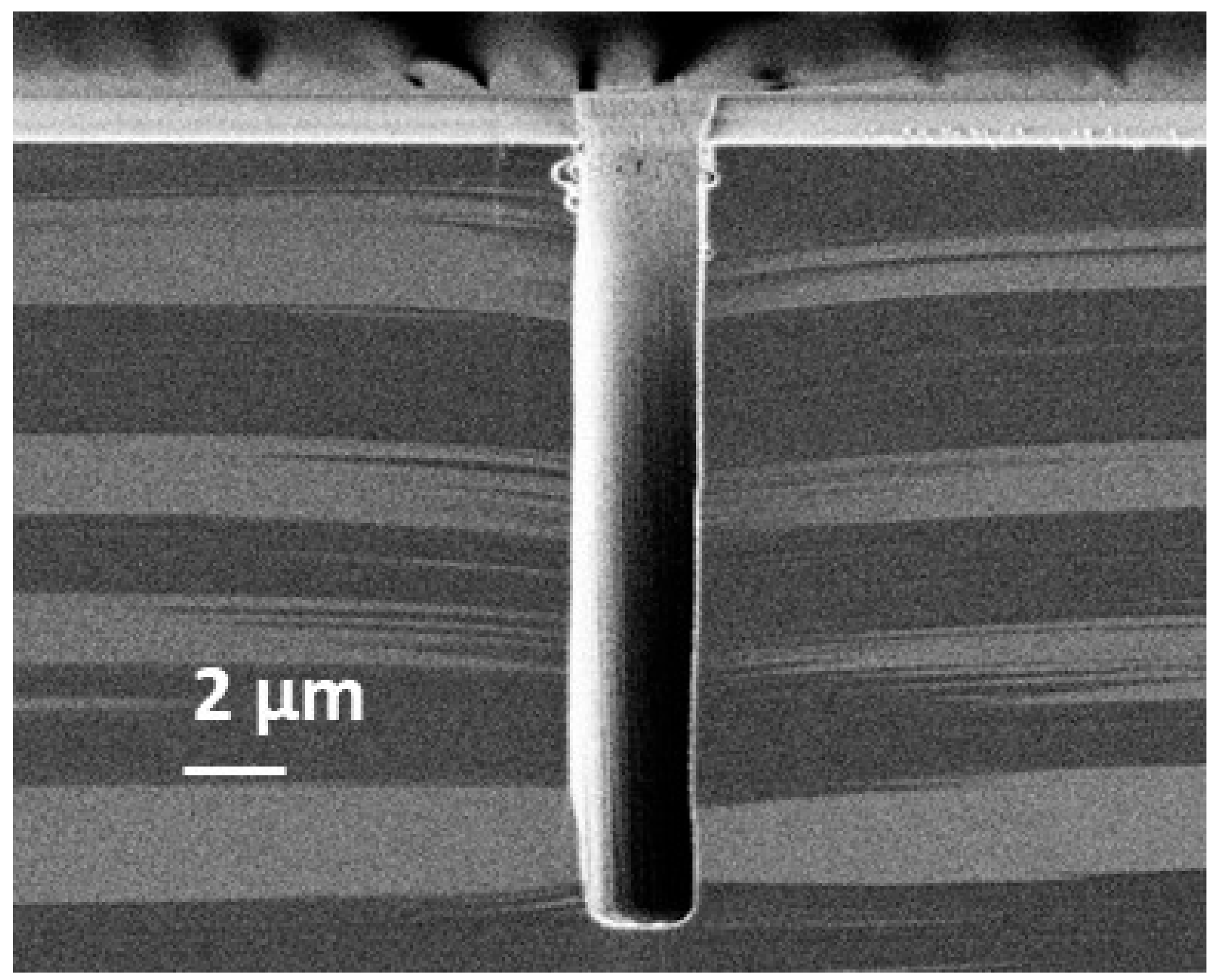Comparison between Bosch and STiGer Processes for Deep Silicon Etching
Abstract
:1. Introduction
2. Materials and Methods
3. Results and Discussion
3.1. Description of the STiGer Process and First Comparison to the Bosch Process
3.2. Comparison of Profiles Etched by the STiGer and the Bosch Processes
3.3. Perspectives for the STiGer Process
4. Conclusions
Author Contributions
Funding
Institutional Review Board Statement
Data Availability Statement
Conflicts of Interest
References
- Laemer, F.; Schilp, A. Method for Anisotropic Plasma Etching of Substrates. U.S. Patent 5498312A, 12 March 1996. [Google Scholar]
- Laermer, F.; Urban, A. MEMS at Bosch—Si Plasma Etch Success Story, History, Applications, and Products. Plasma Process. Polym. 2019, 16, 1800207. [Google Scholar] [CrossRef]
- Blauw, M.A.; Zijlstra, T.; van der Drift, E. Balancing the Etching and Passivation in Time-Multiplexed Deep Dry Etching of Silicon. J. Vac. Sci. Technol. B 2001, 19, 2930. [Google Scholar] [CrossRef]
- Burkett, S.L.; Jordan, M.B.; Schmitt, R.P.; Menk, L.A.; Hollowell, A.E. Tutorial on Forming Through-Silicon Vias. J. Vacuum Sci. Technol. A 2020, 38, 031202. [Google Scholar] [CrossRef] [Green Version]
- Baracu, A.M.; Dirdal, C.A.; Avram, A.M.; Dinescu, A.; Muller, R.; Jensen, G.U.; Thrane, P.C.V.; Angelskår, H. Metasurface Fabrication by Cryogenic and Bosch Deep Reactive Ion Etching. Micromachines 2021, 12, 501. [Google Scholar] [CrossRef] [PubMed]
- Gerlt, M.S.; Läubli, N.F.; Manser, M.; Nelson, B.J.; Dual, J. Reduced Etch Lag and High Aspect Ratios by Deep Reactive Ion Etching (DRIE). Micromachines 2021, 12, 542. [Google Scholar] [CrossRef] [PubMed]
- Jansen, H.V.; de Boer, M.J.; Unnikrishnan, S.; Louwerse, M.C.; Elwenspoek, M.C. Black Silicon Method: X. A Review on High Speed and Selective Plasma Etching of Silicon with Profile Control: An in-Depth Comparison between Bosch and Cryostat DRIE Processes as a Roadmap to next Generation Equipment. J. Micromech. Microeng. 2009, 19, 033001. [Google Scholar] [CrossRef]
- Osipov, A.A.; Iankevich, G.A.; Berezenko, V.I.; Endiiarova, E.V. Influence of Operation Parameters on BOSCH-Process Technological Characteristics. Mater. Today Proc. 2020, 30, 599–602. [Google Scholar] [CrossRef]
- Laermer, F.; Urban, A. Through-Silicon Vias Using Bosch DRIE Process Technology. In Ultra-thin Chip Technology and Applications; Burghartz, J., Ed.; Springer: New York, NY, USA, 2011; pp. 81–91. ISBN 978. [Google Scholar]
- Tachi, S.; Tsujimoto, K.; Okudaira, S. Low-temperature Reactive Ion Etching and Microwave Plasma Etching of Silicon. Appl. Phys. Lett. 1988, 52, 616–618. [Google Scholar] [CrossRef]
- Tachi, S.; Tsujimoto, K.; Arai, S.; Kure, T. Low-temperature Dry Etching. J. Vac. Sci. Technol. A Vac. Surf. Film. 1991, 9, 796–803. [Google Scholar] [CrossRef]
- Bartha, J.W.; Greschner, J.; Puech, M.; Maquin, P. Low Temperature Etching of Si in High Density Plasma Using SF6/O. Microelectron. Eng. 1995, 27, 453–456. [Google Scholar] [CrossRef]
- Walker, M.J. Comparison of Bosch and Cryogenic Processes for Patterning High-Aspect-Ratio Features in Silicon. In Proceedings of the SPIE 4407 MEMS Design, Fabrication, Characterization, and Packaging, Edinburgh, UK, 30 April 2001; pp. 89–99. [Google Scholar] [CrossRef]
- Tillocher, T.; Dussart, R.; Overzet, L.J.; Mellhaoui, X.; Lefaucheux, P.; Boufnichel, M.; Ranson, P. Two Cryogenic Processes Involving SF6, O2, and SiF4 for Silicon Deep Etching. J. Electrochem. Soc. 2008, 155, D187. [Google Scholar] [CrossRef]
- Dussart, R.; Lefaucheux, P.; Mellhaoui, X.; Overzet, L.J.; Ranson, P.; Tillocher, T. Deep Anisotropic Silicon Etch Method. US Patent US20080293250A1, 3 April 2008. [Google Scholar]
- Dussart, R.; Tillocher, T.; Lefaucheux, P.; Boufnichel, M. Plasma Cryogenic Etching of Silicon: From the Early Days to Today’s Advanced Technologies. J. Phys. D Appl. Phys. 2014, 47, 123001. [Google Scholar] [CrossRef]
- Antoun, G.; Dussart, R.; Tillocher, T.; Lefaucheux, P.; Cardinaud, C.; Girard, A.; Tahara, S.; Yamazaki, K.; Yatsuda, K.; Faguet, J.; et al. The Role of Physisorption in the Cryogenic Etching Process of Silicon. Jpn. J. Appl. Phys. 2019, 58, SEEB03. [Google Scholar] [CrossRef]
- Antoun, G. Cryo-Atomic Layer Etching by Plasma: Mechanisms and Processes. Ph.D. Thesis, University of Orleans, Orléans, France, 2020. [Google Scholar]
- Mellhaoui, X.; Dussart, R.; Tillocher, T.; Lefaucheux, P.; Ranson, P.; Boufnichel, M.; Overzet, L.J. SiOxFy Passivation Layer in Silicon Cryoetching. J. Appl. Phys. 2005, 98, 104901. [Google Scholar] [CrossRef]
- Kafrouni, W.; Tillocher, T.; Ladroue, J.; Lefaucheux, P.; Boufnichel, M.; Ranson, P.; Dussart, R. Parametric Study of STiGer Etching Process in Order to Reduce Extended Formation of Scalloping Defects on the Sidewalls of Silicon Submicron Trenches. Vacuum 2016, 133, 90–97. [Google Scholar] [CrossRef]
- Pichon-Balmadier, L. Etude et Optimisation Du Procédé STiGer de Gravure Profonde Du Silicium. Ph.D. Thesis, University of Orleans, Orléans, France, 2010. [Google Scholar]
- Xu, T.; Tao, Z.; Li, H.; Tan, X.; Li, H. Effects of Deep Reactive Ion Etching Parameters on Etching Rate and Surface Morphology in Extremely Deep Silicon Etch Process with High Aspect Ratio. Adv. Mech. Eng. 2017, 9, 168781401773815. [Google Scholar] [CrossRef] [Green Version]
- Labelle, C.B.; Donnelly, V.M.; Bogart, G.R.; Opila, R.L.; Kornblit, A. Investigation of Fluorocarbon Plasma Deposition from C-C4F8 for Use as Passivation during Deep Silicon Etching. J. Vac. Sci. Technol. A Vac. Surf. Film. 2004, 22, 2500–2507. [Google Scholar] [CrossRef]
- Chen, K.-S.; Ayon, A.A.; Zhang, X.; Spearing, S.M. Effect of Process Parameters on the Surface Morphology and Mechanical Performance of Silicon Structures after Deep Reactive Ion Etching (DRIE). J. Microelectromech. Syst. 2002, 11, 264–275. [Google Scholar] [CrossRef] [Green Version]
- Tillocher, T.; Kafrouni, W.; Ladroue, J.; Lefaucheux, P.; Boufnichel, M.; Ranson, P.; Dussart, R. Optimization of Submicron Deep Trench Profiles with the STiGer Cryoetching Process: Reduction of Defects. J. Micromech. Microeng. 2011, 21, 085005. [Google Scholar] [CrossRef]
- Meng, L.; Yan, J. Effect of Process Parameters on Sidewall Damage in Deep Silicon Etch. J. Micromech. Microeng. 2015, 25, 035024. [Google Scholar] [CrossRef]
- Abhulimen, I.U.; Polamreddy, S.; Burkett, S.; Cai, L.; Schaper, L. Effect of Process Parameters on via Formation in Si Using Deep Reactive Ion Etching. J. Vac. Sci. Technol. B 2007, 25, 1762. [Google Scholar] [CrossRef]
- Meng, L.; Yan, J. Mechanism Study of Sidewall Damage in Deep Silicon Etch. Appl. Phys. A 2014, 117, 1771–1776. [Google Scholar] [CrossRef]
- Choi, J.W.; Loh, W.L.; Praveen, S.K.; Murphy, R.; Swee, E.T.K. A Study of the Mechanisms Causing Surface Defects on Sidewalls during Si Etching for TSV (through Si Via). J. Micromech. Microeng. 2013, 23, 065005. [Google Scholar] [CrossRef]
- Chang, B.; Leussink, P.; Jensen, F.; Hübner, J.; Jansen, H. DREM: Infinite Etch Selectivity and Optimized Scallop Size Distribution with Conventional Photoresists in an Adapted Multiplexed Bosch DRIE Process. Microelectron. Eng. 2018, 191, 77–83. [Google Scholar] [CrossRef]
- Lin, P.; Xie, X.; Wang, Y.; Lian, B.; Zhang, G. A Multi-Step Etch Method for Fabricating Slightly Tapered through-Silicon Vias Based on Modified Bosch Process. Microsyst. Technol. 2019, 25, 2693–2698. [Google Scholar] [CrossRef]
- Tinck, S.; Tillocher, T.; Georgieva, V.; Dussart, R.; Neyts, E.; Bogaerts, A. Concurrent Effects of Wafer Temperature and Oxygen Fraction on Cryogenic Silicon Etching with SF6/O2 Plasmas. Plasma Process. Polym. 2017, 14, 1700018. [Google Scholar] [CrossRef]
- Fursenko, O.; Bauer, J.; Marschmeyer, S.; Stoll, H.-P. Through Silicon via Profile Metrology of Bosch Etching Process Based on Spectroscopic Reflectometry. Microelectron. Eng. 2015, 139, 70–75. [Google Scholar] [CrossRef]





| Parameters | Bosch | STiGer | ||
|---|---|---|---|---|
| Etching | Passivation | Etching | Passivation | |
| Gas | SF6 | C4F8 | SF6 | SiF4/O2 |
| Flow (sccm) | 50 | 27 | 50 | 25/12 |
| Cycle time (s) | 15 | 10 | 15 | 7 s |
| Pressure (Pa) | 3.0 | 2.0 | 3.9 | 1.2 |
| Source power (W) | 1500 | 1500 | 1500 | 1500 |
| Self-bias voltage (V) | 80 | 105 | 80 | 30 |
| Temperature (°C) | 21.4 °C | −90.0 °C | ||
| Total time | 12 min 30 s | 11 min | ||
| Number of cycles | 30 | 30 | ||
| Process | Profile | Depth | Etch Rate (µm/min) | Si:SiO2 Selectivity |
|---|---|---|---|---|
| Bosch process | Vertical | 31.2 µm | 2.50 | 138 |
| STiGer process | Vertical | 27.8 µm | 2.53 | 185 |
| Parameter | Bosch | STiGer |
|---|---|---|
| Substrate temperature | Room temperature | T < −50 °C |
| Passivation chemistry | Fluoropolymer | Fluoropolymer free |
| Average etch rate | Similar | |
| Sidewall roughness | Similar (scalloping) | |
| Process stability versus temperature | Very stable | Stable over a temperature range of 20 °C |
| Chamber clean | Yes | No |
| Specific hardware feature | - Heated chamber walls and pumps - Fast MFC | - Liquid nitrogen for T around −100 °C - Low temperature chiller around −50 °C - Fast MFC |
Publisher’s Note: MDPI stays neutral with regard to jurisdictional claims in published maps and institutional affiliations. |
© 2021 by the authors. Licensee MDPI, Basel, Switzerland. This article is an open access article distributed under the terms and conditions of the Creative Commons Attribution (CC BY) license (https://creativecommons.org/licenses/by/4.0/).
Share and Cite
Tillocher, T.; Nos, J.; Antoun, G.; Lefaucheux, P.; Boufnichel, M.; Dussart, R. Comparison between Bosch and STiGer Processes for Deep Silicon Etching. Micromachines 2021, 12, 1143. https://doi.org/10.3390/mi12101143
Tillocher T, Nos J, Antoun G, Lefaucheux P, Boufnichel M, Dussart R. Comparison between Bosch and STiGer Processes for Deep Silicon Etching. Micromachines. 2021; 12(10):1143. https://doi.org/10.3390/mi12101143
Chicago/Turabian StyleTillocher, Thomas, Jack Nos, Gaëlle Antoun, Philippe Lefaucheux, Mohamed Boufnichel, and Rémi Dussart. 2021. "Comparison between Bosch and STiGer Processes for Deep Silicon Etching" Micromachines 12, no. 10: 1143. https://doi.org/10.3390/mi12101143






